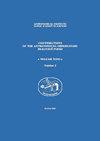Composite spectrum hot subdwarf binaries
IF 0.2
4区 物理与天体物理
Q4 ASTRONOMY & ASTROPHYSICS
Contributions of the Astronomical Observatory Skalnate Pleso
Pub Date : 2020-03-01
DOI:10.31577/caosp.2020.50.2.546
引用次数: 0
Abstract
The formation of hot subdwarf stars (sdB) is closely related to binary evolution on the red giant branch. Observations show that hot subdwarfs are either in close binaries with low mass K-M type or white dwarf companions, or in wide binaries with more massive F-G type companions. A small fraction is most strikingly single. In close binaries the radiative interactions give rise to the reflection effect and produces a variable composite spectrum. More massive companions bear similar optical luminosities as sdB stars and therefore double-lined spectra are observed. To investigate such systems in detail and precision spectral decomposition/disentangling is needed. I describe our wavelength space disentangling method and bring examples why such an approach to composite spectra offers a potential to find the history of hot subdwarfs.复合光谱热亚矮星双星
热亚矮星(sdB)的形成与红巨星分支上的双星演化密切相关。观测表明,热亚矮星要么是在有低质量K-M型或白矮星伴星的近距离双星中,要么是在有质量更大的F-G型伴星的宽距离双星中。有一小部分是最惊人的单身。在紧密的双星中,辐射相互作用引起反射效应,产生可变的复合光谱。更多的大质量伴星具有与sdB恒星相似的光学光度,因此可以观察到双线光谱。为了详细研究这类系统,需要进行精确的光谱分解/解纠缠。我将介绍我们的波长空间解纠缠方法,并举例说明为什么这种复合光谱方法有可能找到热亚矮星的历史。
本文章由计算机程序翻译,如有差异,请以英文原文为准。
求助全文
约1分钟内获得全文
求助全文
来源期刊
CiteScore
1.10
自引率
20.00%
发文量
4
审稿时长
>12 weeks
期刊介绍:
Contributions of the Astronomical Observatory Skalnate Pleso" (CAOSP) is published by the Astronomical Institute of the Slovak Academy of Sciences (SAS). The journal publishes new results of astronomical and astrophysical research, preferentially covering the fields of Interplanetary Matter, Stellar Astrophysics and Solar Physics. We publish regular papers, expert comments and review contributions.

 求助内容:
求助内容: 应助结果提醒方式:
应助结果提醒方式:


